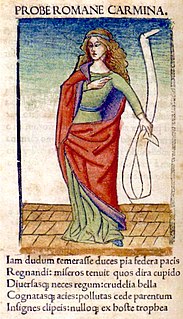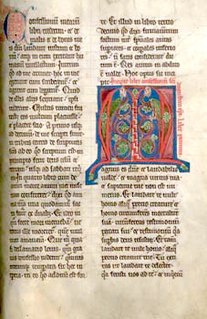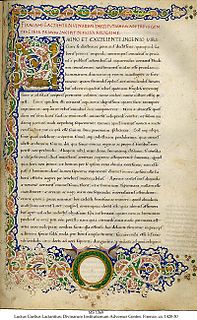 W
WApicius is a collection of Roman cookery recipes, thought to have been compiled in the 1st century AD and written in a language in many ways closer to Vulgar than to Classical Latin; later recipes using Vulgar Latin were added to earlier recipes using Classical Latin. Based on textual analysis, the food scholar Bruno Laurioux believes that the surviving version only dates from the fifth century : "The history of De Re Coquinaria indeed belongs then to the Middle Ages".
 W
WCento Vergilianus de laudibus Christi is a Latin poem arranged by Faltonia Betitia Proba after her conversion to Christianity. A cento is a poetic work composed of verses or passages taken from other authors and re-arranged in a new order. This poem reworks verses extracted from the work of Virgil to tell stories from the Old and New Testament of the Christian Bible. Much of the work focuses on the story of Jesus Christ.
 W
WConfessions is an autobiographical work by Saint Augustine of Hippo, consisting of 13 books written in Latin between AD 397 and 400. The work outlines Saint Augustine's sinful youth and his conversion to Christianity. Modern English translations of it are sometimes published under the title The Confessions of Saint Augustine in order to distinguish the book from other books with similar titles. Its original title was Confessions in Thirteen Books, and it was composed to be read out loud with each book being a complete unit.
 W
WDe doctrina Christiana is a theological text written by Augustine of Hippo. It consists of four books that describe how to interpret and teach the Scriptures. The first three of these books were published in 397 and the fourth added in 426. By writing this text, Augustine set three tasks for Christian teachers and preachers: to discover the truth in the contents of the Scriptures, to teach the truth from the Scriptures, and to defend scriptural truth when it was attacked.
 W
WDe re militari, also Epitoma rei militaris, is a treatise by the Late Latin writer Publius Flavius Vegetius Renatus about Roman warfare and military principles as a presentation of the methods and practices in use during the height of the Roman Empire and responsible for its power. The extant text dates to the 5th century.
 W
WDe rebus bellicis is an anonymous work of the 4th or 5th century which suggests remedies for the military and financial problems in the Roman Empire, including a number of fanciful war machines. It was written after the death of Constantine I in 337 and before the fall of the Western Roman Empire in 476. Some researchers suggest that it may refer to the Battle of Adrianople of 378, or even the death of Emperor Theodosius I in 395, as it uses the plural form of the word "princeps", the title of the emperor, which may refer to the split of the Empire between Honorius and Arcadius after the death of Theodosius.
 W
WDe Viris Illustribus is a collection of short biographies of 135 authors, written in Latin, by the 4th-century Latin Church Father Jerome. He completed this work at Bethlehem in 392-3 AD. The work consists of a prologue plus 135 chapters, each consisting of a brief biography. Jerome himself is the subject of the final chapter. A Greek version of the book, possibly by the same Sophronius who is the subject of Chapter 134, also survives. Many biographies take as their subject figures important in Christian Church history and pay especial attention to their careers as writers. It "was written as an apologetic work to prove that the Church had produced learned men." The book was dedicated to Flavius Lucius Dexter, who served as high chamberlain to Theodosius I and as praetorian prefect to Honorius. Dexter was the son of Saint Pacianus, who is eulogized in the work.
 W
WThe Distichs of Cato, is a Latin collection of proverbial wisdom and morality by an unknown author named Dionysius Cato from the 3rd or 4th century AD. The Cato was the most popular medieval schoolbook for teaching Latin, prized not only as a Latin textbook, but as a moral compass. Cato was in common use as a Latin teaching aid as late as the 18th century, used by Benjamin Franklin. It was one of the best-known books in the Middle Ages and was translated into many languages.
 W
WInstitutiones Divinae is the name of a theological work by the Christian Roman philosopher Lactantius, written between AD 303 and 311.
 W
WThe Historia Augusta is a late Roman collection of biographies, written in Latin, of the Roman emperors, their junior colleagues, designated heirs and usurpers from 117 to 284. Supposedly modeled on the similar work of Suetonius, The Twelve Caesars, it presents itself as a compilation of works by six different authors, written during the reigns of Diocletian and Constantine I and addressed to those emperors or other important personages in Ancient Rome. The collection, as extant, comprises thirty biographies, most of which contain the life of a single emperor, but some include a group of two or more, grouped together merely because these emperors were either similar or contemporaneous.
 W
WThe Vergilius Augusteus is a manuscript from late antiquity, containing the works of the Roman author Virgil, written probably around the 4th century. There are two other collections of Virgil manuscripts, the Vergilius Vaticanus and the Vergilius Romanus. They are early examples of illuminated manuscripts; the Augusteus is not illuminated but has decorated initial letters at the top of each page. These letters do not mark divisions of the text, but rather are used at the beginning of whatever line happened to fall at the top of the page. These decorated initials are the earliest surviving such initials.